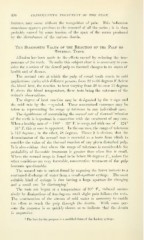Page 408 - My FlipBook
P. 408
406 CONSERVATIVE TREATMENT OF THE PULP.
features, may occur without the recognition of pain. This indication
sometimes aj)i">ears previous to the removal of all the caries; it is then
pi'obably caused by some tension of the apex of the cornu produced
by the disturbance of the carious dentin.
The Diagnostic Value of the Reaction of the Pulp to
Thermal Tests.
Allusion has been made to the efFects caused by reducing the tem-
perature of the teeth. To make this subject clear it is necessary to con-
sider the reaction of the dental pulp to thermal changes in its states of
health and of disease.
The normal rate at which the pulp of sound teeth reacts to cold
applications varies with different persons from 22 to 66 degrees F. below
the blood heat, the reaction to heat varying from 20 to over 55 degrees
F. above the blood temperature, these tests being the extremes of the
writer's observations.
The degree of heat reaction may be designated by the + sign and
the cold rate by the — symbol. These ascertained extremes may be
taken as representing the ranr/e of tolerance in any individual case.
The significance of ascertaining the normal rate of thermal irritation
of the teeth is important in connection with the treatment of any case.
When a healthy rate of + 144° - 32° F. is compared with one of + 124°
— 76° F. this at once is apparent. In the one case, the range of tolerance
is 112 degrees ; in the other, 48 degrees. Hence it is obvious that the
determination of the normal rate is essential as a basis from which to
consider the value of the thermal reaction of any given disturbed pulp.
It is also evident that where the range of tolerance is considerable the
probability of favorable treatment is greater than when this is small.
Where the normal range is found to be below 50 degrees F., unless the
other conditions are very favorable, conservative treatment of the pulp
becomes questionable.
The normal rate is easiest found by exposing the lower incisors to a
continued discharge of water from a small-aperture syringe. The most
suitable kind of syringe is that having a large aperture for charging
and a small one for discharging.^
The tests are begun at a temperature of 80° F., reduced succes-
sively by diminutions of ten degrees until slight pain follows the tests.
The continuation of the stream of cold water is necessary to enable
the effect to reach the pulp through the dentin. With some per-
sons the response is so quickly shown as to indicate that the dentin
is responsive.
^ The best for the purpose is a modified form of the Laskey syringe.


